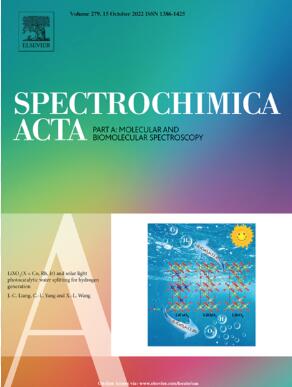Imidazo-phenanthroline based ratiometric optical sensing platform for cyanide and fluoride ions
IF 4.3
2区 化学
Q1 SPECTROSCOPY
Spectrochimica Acta Part A: Molecular and Biomolecular Spectroscopy
Pub Date : 2025-04-03
DOI:10.1016/j.saa.2025.126123
引用次数: 0
Abstract
The severe toxicity and widespread distribution of fluoride (F−) and cyanide (CN−) ions in various environmental matrices highlight the urgent need for their efficient and reliable detection methods. In this study, we present a fluorogenic imidazo-phenanthroline based probe (L) for selective detection of F− and CN− in semi-aqueous medium. Probe L exhibits a pronounced ratiometric fluorescence response upon interaction with these anions, driven by hydrogen bonding interaction involving the N–H group of the imidazole moiety. Notably, L enables clear discrimination of CN− from other anions through a distinct color change, with an impressive detection limit in the nanomolar (nM) range. To enhance its practical applicability, paper-based sensing strips embedded with L were developed, effectively detecting CN− and F− under UV light illumination. The probe’s exceptional sensitivity and selectivity could be attributed to the strong acidity of the N–H proton, facilitating efficient hydrogen bonding interactions followed by deprotonation. The binding mechanism was thoroughly investigated using Job’s plot, NMR, and DFT analyses. Additionally, L demonstrated versatility in environmental and biological applications, successfully detecting cyanide and fluoride ions in soil samples and identifying F− in live MCF-7 cell lines via blue fluorescence channel imaging.

求助全文
约1分钟内获得全文
求助全文
来源期刊
CiteScore
8.40
自引率
11.40%
发文量
1364
审稿时长
40 days
期刊介绍:
Spectrochimica Acta, Part A: Molecular and Biomolecular Spectroscopy (SAA) is an interdisciplinary journal which spans from basic to applied aspects of optical spectroscopy in chemistry, medicine, biology, and materials science.
The journal publishes original scientific papers that feature high-quality spectroscopic data and analysis. From the broad range of optical spectroscopies, the emphasis is on electronic, vibrational or rotational spectra of molecules, rather than on spectroscopy based on magnetic moments.
Criteria for publication in SAA are novelty, uniqueness, and outstanding quality. Routine applications of spectroscopic techniques and computational methods are not appropriate.
Topics of particular interest of Spectrochimica Acta Part A include, but are not limited to:
Spectroscopy and dynamics of bioanalytical, biomedical, environmental, and atmospheric sciences,
Novel experimental techniques or instrumentation for molecular spectroscopy,
Novel theoretical and computational methods,
Novel applications in photochemistry and photobiology,
Novel interpretational approaches as well as advances in data analysis based on electronic or vibrational spectroscopy.

 求助内容:
求助内容: 应助结果提醒方式:
应助结果提醒方式:


